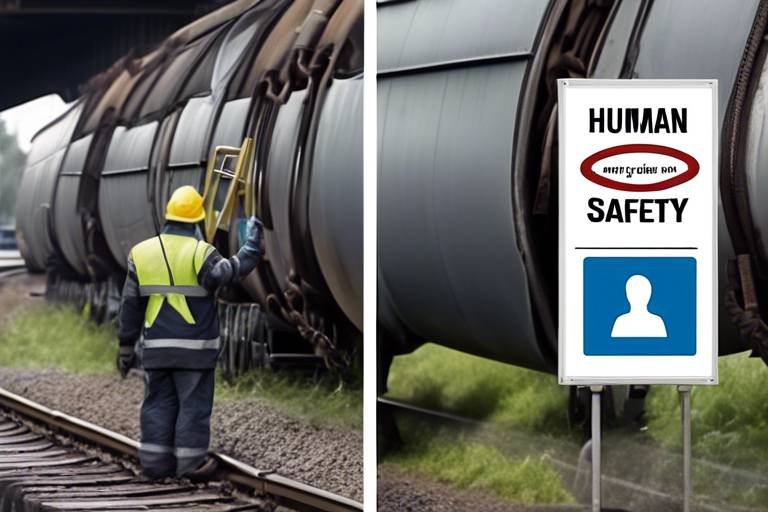Implementing Safety Measures: Reading Human Behavior Guides the Way
In today's world, the implementation of effective safety measures is not just a protocol; it’s a necessity. But here’s the catch: **understanding human behavior** is the key to unlocking successful safety strategies. Think of it like this: if you’re trying to teach someone to ride a bike, knowing how they think and react to balance can make all the difference. Similarly, when it comes to safety, recognizing the **nuances of human behavior** can lead to more effective and tailored safety measures. This article dives deep into the significance of human behavior in safety protocols, offering insights and strategies that can enhance safety across various environments.
Why is understanding human behavior so crucial in safety? The answer lies in the fact that people are often the weakest link in safety systems. Whether in a workplace, at home, or in public spaces, human actions can either bolster safety or compromise it. For instance, consider a construction site where workers are trained to wear helmets. If they feel invincible or underestimate the risks, they might choose not to wear them. This behavior can lead to accidents that could have been easily avoided. Thus, **tailored approaches** in safety planning that consider individual and group behaviors are essential. By understanding what drives people’s decisions, organizations can create safety measures that resonate with their employees and the public alike.
Diving deeper, let’s explore some key behavioral insights that can inform safety protocols. The role of psychology in predicting and influencing safe behaviors cannot be overstated. For instance, have you ever noticed how people tend to follow the crowd? This phenomenon, known as **social proof**, can be leveraged to promote safer behaviors. If everyone in a workplace wears their safety gear, new employees are more likely to follow suit. Furthermore, understanding the psychological factors that influence decisions can help in crafting messages that encourage safe practices. It’s all about tapping into the **human psyche** to foster a culture of safety.
One of the most significant aspects of human behavior in safety is **risk perception**. How individuals assess risks can greatly influence their decision-making processes. For instance, someone who perceives a low risk in a task may take shortcuts that jeopardize their safety. Conversely, an individual who recognizes the potential dangers will likely adhere to safety protocols. This understanding is crucial for designing safety measures that resonate with people’s perceptions. It’s about aligning safety communications with how individuals view risks. But what factors influence this perception? Let’s break it down.
Various elements shape our perception of risk, including:
- Past Experiences: Previous encounters with danger can heighten awareness and caution.
- Social Influences: The behaviors and attitudes of peers can significantly affect one's perception of risk.
- Media Exposure: News reports and social media can amplify fears or downplay risks.
Understanding these factors is essential for creating effective safety communications and interventions. When we tailor our messages to address these influences, we can foster a more safety-conscious environment.
Enhancing decision-making processes is vital for safety. Imagine a firefighter making split-second decisions in a burning building. Their training, shaped by understanding human behavior, allows them to act swiftly and safely. Similarly, in everyday situations, we can guide individuals toward making safer choices through clear communication and training. Providing scenarios, role-playing exercises, and decision-making frameworks can empower people to act responsibly in high-risk situations.
Establishing a strong safety culture is essential for promoting safe behaviors. A safety culture is not just about rules and regulations; it’s about fostering an environment where safety is prioritized and ingrained in daily activities. This involves leadership commitment, employee engagement, and continuous improvement. Think of it as a garden; it needs nurturing, attention, and the right conditions to thrive. By cultivating a culture that values safety, organizations can significantly reduce incidents and enhance overall well-being.
Training and education play a pivotal role in enhancing safety behaviors. It’s not enough to simply hand out safety manuals or conduct one-time training sessions. Instead, effective training approaches should incorporate behavioral insights to improve safety awareness and practices. This means understanding how people learn and what motivates them to apply their knowledge in real-world scenarios.
Engaging training methods can enhance the retention and application of safety knowledge. For example, using interactive workshops, simulations, and hands-on activities can cater to diverse learning styles. When participants are actively involved, they are more likely to remember and apply what they’ve learned. It’s about making safety training not just informative but also enjoyable and relevant.
Finally, evaluating the effectiveness of safety training is crucial for continuous improvement. Organizations should regularly assess training outcomes through feedback, quizzes, and practical assessments. This not only helps in identifying areas for improvement but also ensures that safety measures are effectively implemented. After all, a robust safety program is a living, breathing entity that evolves with the organization and its people.
Q: Why is understanding human behavior important for safety measures?
A: Understanding human behavior helps tailor safety measures to align with how people think and act, ultimately leading to more effective safety protocols.
Q: How can risk perception affect safety decisions?
A: Risk perception influences how individuals assess dangers and make decisions, impacting their adherence to safety measures.
Q: What are some effective training methods for safety?
A: Engaging training methods include interactive workshops, simulations, and hands-on activities that cater to various learning styles.
Q: How can organizations create a strong safety culture?
A: A strong safety culture can be fostered through leadership commitment, employee engagement, and continuous improvement in safety practices.

The Importance of Human Behavior in Safety
Understanding human behavior is crucial for developing effective safety measures. Why? Because at the heart of every safety protocol are the people it aims to protect. Our actions, decisions, and reactions often determine the success or failure of safety initiatives. When we grasp the nuances of human behavior, we can tailor our safety strategies to resonate more deeply with individuals, leading to better outcomes. Consider a fire drill: if participants don’t perceive it as relevant or important, their response will likely be lackadaisical. However, if they understand the potential dangers and their roles in an emergency, they are more likely to engage seriously and act appropriately.
Moreover, behaviors influence safety outcomes in multifaceted ways. For instance, the way employees interact with safety equipment can either enhance or undermine safety protocols. If workers are trained to see safety gear as a burden rather than a necessity, they may neglect to use it correctly. This mindset can stem from a variety of factors, including workplace culture, previous experiences, or even peer influence. Therefore, it’s essential to foster a culture that not only emphasizes the importance of safety measures but also encourages positive behaviors. In this context, understanding the psychology behind these behaviors becomes a powerful tool in safety planning.
To illustrate, let’s look at a few key elements that highlight the importance of human behavior in safety:
- Behavioral Compliance: When individuals understand the rationale behind safety rules, they are more likely to comply. This compliance is not just about following orders; it’s about fostering a sense of responsibility for one’s own safety and that of others.
- Communication: Clear communication can significantly impact how safety measures are perceived and implemented. Engaging employees in discussions about safety can lead to a shared understanding and commitment to safe practices.
- Feedback Loops: Establishing mechanisms for feedback allows individuals to express concerns or suggestions regarding safety protocols. This not only improves safety measures but also empowers employees, making them feel valued and heard.
In summary, the importance of human behavior in safety cannot be overstated. By recognizing and addressing the psychological and social factors that influence behavior, organizations can create a more effective safety environment. This approach not only enhances compliance and engagement but also fosters a culture where safety is seen as a shared responsibility, ultimately leading to better outcomes for everyone involved.

Behavioral Insights for Safety Protocols
When it comes to safety, understanding the intricacies of human behavior is not just a nice-to-have; it’s a necessity. Our actions, reactions, and interactions are deeply influenced by psychological factors that can either enhance or jeopardize safety protocols. By delving into behavioral insights, organizations can craft safety measures that resonate with individuals on a personal level, making them more effective and impactful.
One of the core elements of these insights is the concept of risk perception. How individuals perceive risk can drastically influence their behavior in safety-critical situations. For instance, someone who has previously experienced a minor accident may overestimate the likelihood of future incidents, leading to overly cautious behavior. Conversely, someone who has never encountered an accident might underestimate potential hazards, taking unnecessary risks. Understanding this dichotomy is crucial for tailoring safety communications. It allows organizations to address specific concerns and beliefs that shape individual perceptions.
Moreover, the psychological factors that influence risk perception include social norms, past experiences, and even cultural backgrounds. For instance, if a workplace fosters a culture where safety is prioritized and openly discussed, employees are more likely to adopt safe behaviors. This brings us to the concept of creating a safety culture. A robust safety culture encourages open communication about risks and promotes shared responsibility for safety among all members of an organization. When everyone feels accountable, it can lead to a collective shift in behavior that enhances overall safety.
In addition to risk perception, enhancing decision-making processes is vital in promoting safety. Individuals often face high-pressure situations where quick decisions are necessary. Training programs that focus on improving decision-making skills can empower employees to make safer choices under pressure. For example, simulations that mimic real-life scenarios can help individuals practice their responses to potential hazards, thus improving their readiness and confidence in actual situations.
To illustrate how behavioral insights can be integrated into safety protocols, consider the following table that outlines key behavioral factors and their implications for safety measures:
| Behavioral Factor | Implication for Safety Protocols |
|---|---|
| Risk Perception | Tailor communications to address specific concerns and beliefs. |
| Social Norms | Encourage a culture of safety through peer influence and accountability. |
| Past Experiences | Use case studies to highlight the importance of safety measures. |
| Decision-Making Skills | Implement training that enhances quick and safe decision-making. |
In conclusion, integrating behavioral insights into safety protocols is not just about following rules; it’s about understanding the human element behind those rules. By recognizing how individuals perceive risk and make decisions, organizations can create a safer environment that not only protects but also empowers their workforce. After all, safety isn’t just a policy; it’s a culture that thrives on understanding and collaboration.
- Why is understanding human behavior important for safety protocols?
Understanding human behavior allows organizations to tailor safety measures to address specific perceptions and decision-making processes, leading to more effective safety outcomes. - How can organizations create a safety culture?
By fostering open communication, encouraging accountability, and providing training that emphasizes safety, organizations can cultivate a culture where safety is prioritized by everyone. - What role does risk perception play in safety?
Risk perception influences how individuals assess hazards and make decisions, which can significantly impact their behavior in safety-critical situations.

Risk Perception and Decision-Making
Risk perception is a fascinating psychological phenomenon that plays a pivotal role in our decision-making processes, especially when it comes to safety. Imagine you're standing at the edge of a cliff, the wind whipping through your hair. The thrill of the view is exhilarating, but the thought of falling can send shivers down your spine. This scenario illustrates how our minds constantly evaluate risks based on personal experiences, social influences, and even media portrayals. Understanding how individuals assess risks is crucial for designing safety measures that resonate with their perceptions.
When we talk about risk perception, it’s essential to recognize that it’s not merely about the actual danger present but rather how individuals interpret that danger. For instance, consider two people standing on that same cliff. One might feel confident in their footing and view the experience as an adventure. The other may be gripped by fear, perceiving the risk of falling as overwhelmingly high. This divergence in perception can lead to vastly different decisions regarding safety, whether it’s choosing to take a step closer to the edge or opting to stay back.
Several factors influence how we perceive risk, including:
- Past Experiences: If someone has previously experienced a fall or a near-miss, their perception of risk might be heightened.
- Social Influences: Friends or family who express fear or caution can significantly sway an individual's risk assessment.
- Media Exposure: News stories about accidents can amplify perceived risks, making individuals more cautious.
These factors highlight the importance of tailoring safety measures to address specific perceptions. For example, if a workplace is prone to accidents, understanding employees' risk perceptions can help in crafting communication that resonates with their experiences and fears. This can lead to more effective safety protocols that not only inform but also engage employees in a manner that feels relevant to their everyday lives.
Furthermore, improving decision-making processes is vital in safety contexts. Individuals often face high-stakes situations where quick judgments are necessary. By providing clear, concise information about risks and potential outcomes, organizations can guide individuals toward making safer choices. For instance, using visual aids like infographics or simple charts can simplify complex data, making it easier for people to grasp the implications of their choices swiftly.
In conclusion, recognizing the nuances of risk perception and its impact on decision-making is essential for fostering a culture of safety. By understanding how individuals perceive risk, organizations can implement tailored safety measures that not only inform but also empower individuals to make safer decisions in their daily lives.

Factors Influencing Risk Perception
Risk perception is a fascinating and complex aspect of human behavior that can significantly influence safety outcomes. Understanding what shapes our perceptions of risk is crucial for developing effective safety measures. Various factors come into play, including personal experiences, social influences, and even cultural background. Each of these elements can alter how individuals assess risk, leading to either heightened awareness or complacency in dangerous situations.
For instance, individuals who have previously experienced a safety incident may develop a heightened sense of caution, making them more likely to recognize potential hazards. On the other hand, someone who has never faced a particular risk may underestimate its severity. This disparity highlights the importance of addressing individual differences when designing safety protocols.
Moreover, social influences play a significant role in shaping our perceptions of risk. People often look to their peers when evaluating a situation. If a majority believes a certain behavior is safe, others may follow suit, even if evidence suggests otherwise. This phenomenon can lead to dangerous groupthink, where individuals ignore their instincts or the data available to them. To combat this, safety communications must not only provide factual information but also consider the social dynamics at play.
Additionally, cultural background can shape risk perception in profound ways. Different cultures may have varying attitudes toward risk, which can influence decision-making processes. For example, in some cultures, taking risks might be viewed as a sign of bravery, while in others, it could be seen as recklessness. Understanding these cultural nuances is essential when implementing safety measures across diverse populations.
To summarize, the factors influencing risk perception are multifaceted and interrelated. By recognizing the impact of personal experiences, social influences, and cultural backgrounds, organizations can tailor their safety measures to resonate more effectively with individuals. This tailored approach can lead to improved safety behaviors and ultimately create a safer environment for everyone.
Incorporating these insights into safety training and communication can significantly enhance the effectiveness of safety protocols. As we strive to foster a culture of safety, it is imperative to consider how we can better understand and influence risk perception among individuals.
- What is risk perception? Risk perception refers to the subjective judgment people make about the characteristics and severity of a risk.
- How do personal experiences influence risk perception? Personal experiences shape how individuals assess risks, often leading to heightened awareness or underestimation based on past incidents.
- Can social influences affect safety behaviors? Yes, social influences can lead individuals to conform to group perceptions of risk, which may not always align with reality.
- Why is cultural background important in risk perception? Cultural attitudes towards risk can vary significantly, affecting how individuals approach safety and decision-making.

Improving Decision-Making Processes
When it comes to safety, the ability to make quick and informed decisions can mean the difference between a close call and a disaster. Improving decision-making processes is not just about providing information; it's about understanding how people think and react in various situations. Imagine a firefighter facing a blaze: their choices must be swift, yet informed by training and past experiences. Similarly, in any environment, enhancing decision-making can significantly reduce risk and improve safety outcomes.
One of the first steps in improving decision-making is to foster an environment where individuals feel empowered to make choices. This can be achieved through clear communication and establishing a culture of trust. When people understand the importance of their role in safety, they are more likely to engage actively in decision-making processes. For example, in a manufacturing plant, encouraging workers to voice concerns about safety procedures can lead to valuable insights that management may overlook.
Another critical aspect is training. Training programs should focus on real-world scenarios that employees might face. By simulating high-pressure situations, individuals can practice making decisions in a controlled environment, which builds their confidence and prepares them for actual emergencies. For instance, using virtual reality (VR) technology can immerse trainees in realistic scenarios, allowing them to experience the consequences of their decisions without the actual risks. This hands-on approach not only enhances retention but also empowers employees to act decisively when it matters most.
Moreover, understanding cognitive biases is essential for improving decision-making. People often fall prey to biases that skew their judgment, such as overconfidence or the tendency to ignore statistical data in favor of anecdotal evidence. By educating individuals about these biases, organizations can help them recognize and mitigate their effects. For instance, a simple reminder to consider data-driven insights before making a decision can lead to more rational choices. A table summarizing common cognitive biases and strategies to counteract them can serve as an effective reference:
| Cognitive Bias | Description | Counteracting Strategy |
|---|---|---|
| Overconfidence Bias | Overestimating one's knowledge or ability. | Encourage the use of checklists and peer reviews. |
| Confirmation Bias | Favoring information that confirms existing beliefs. | Promote critical thinking and diverse viewpoints. |
| Availability Heuristic | Relying on immediate examples that come to mind. | Provide comprehensive data and case studies. |
Lastly, incorporating feedback loops into decision-making processes can significantly enhance safety outcomes. When individuals receive feedback on their choices, it creates a learning environment where they can continuously improve. For example, after a safety incident, conducting a debriefing session allows the team to analyze what decisions were made and how they could have been improved. This practice not only helps in refining future decision-making but also reinforces a culture of accountability and continuous improvement.
In conclusion, improving decision-making processes is a multifaceted endeavor that requires a combination of training, awareness of cognitive biases, and a supportive culture. By focusing on these areas, organizations can empower individuals to make safer, more informed decisions that ultimately lead to a safer environment for everyone.
- What are the key factors that influence decision-making in safety contexts? Factors include individual training, cognitive biases, and organizational culture.
- How can training improve decision-making? Training provides real-world scenarios that enhance confidence and preparedness.
- Why is feedback important in decision-making? Feedback creates a learning environment, allowing individuals to refine their decision-making skills.

Creating a Safety Culture
Establishing a strong safety culture within an organization is not just a checkbox on a compliance list; it's a fundamental shift in how individuals perceive and engage with safety protocols. A safety culture is the sum of an organization’s values, beliefs, and behaviors regarding safety, and it plays a critical role in ensuring that safety measures are not only implemented but also embraced by everyone involved. Imagine walking into a workplace where safety is not merely discussed during meetings but is a part of the daily conversation—this is the essence of a robust safety culture.
To foster this culture, organizations must prioritize communication and engagement. It starts with leadership that actively demonstrates a commitment to safety. When leaders prioritize safety, it sends a clear message that safety is everyone's responsibility. This can be achieved through regular safety meetings, open forums for discussing safety concerns, and recognition programs that celebrate safe practices among employees. For instance, consider a monthly safety award that recognizes individuals or teams who exemplify safe behaviors. This not only motivates employees but also reinforces the importance of safety in everyday operations.
Moreover, training plays a pivotal role in cultivating a safety culture. It's not enough to provide a one-time training session; ongoing education and reinforcement are essential. This can be achieved through:
- Interactive workshops that engage employees in real-life scenarios.
- Regular drills that keep safety protocols fresh in everyone's mind.
- Feedback mechanisms that allow employees to voice their concerns and suggestions regarding safety practices.
Another significant aspect of a safety culture is fostering an environment where employees feel comfortable reporting unsafe conditions or behaviors without fear of repercussions. This transparency is vital. When employees know they can speak up, it leads to a proactive approach to safety, where potential hazards are addressed before they result in incidents. Organizations can encourage this by implementing anonymous reporting systems and ensuring that all reports are taken seriously and acted upon.
In addition to these strategies, it's essential to measure the effectiveness of safety culture initiatives. Regular surveys and assessments can provide valuable insights into how employees perceive safety within the organization. This data can be used to identify areas for improvement and to tailor safety programs to better meet the needs of the workforce. For instance, if surveys indicate that employees feel under-trained in specific safety protocols, organizations can adjust their training programs accordingly.
Ultimately, creating a safety culture is about more than just compliance; it’s about building a community that values safety as a core principle. By engaging employees, fostering open communication, and continually assessing and improving safety practices, organizations can create a culture where safety is ingrained in every action and decision. This not only protects employees but also enhances overall productivity and morale, making safety a win-win for everyone involved.
Q: What is a safety culture?
A: A safety culture refers to the shared values, beliefs, and behaviors regarding safety within an organization. It emphasizes the importance of safety in daily operations and encourages proactive safety measures.
Q: How can leadership influence safety culture?
A: Leadership sets the tone for safety culture by prioritizing safety in their actions and communications, demonstrating commitment, and encouraging open dialogue about safety concerns.
Q: Why is employee engagement important in safety culture?
A: Engaged employees are more likely to take ownership of safety protocols, report hazards, and participate in safety initiatives, leading to a more proactive and effective safety culture.
Q: How can organizations measure the effectiveness of their safety culture?
A: Organizations can use surveys, assessments, and feedback mechanisms to gauge employee perceptions of safety, identify areas for improvement, and adjust safety programs accordingly.

Training and Education for Safety
Training and education are the backbone of effective safety measures in any organization. Imagine walking into a workplace where every individual is equipped with the knowledge and skills to recognize hazards and respond appropriately. This is not just a dream; it can be a reality through well-structured training programs. The importance of these educational initiatives cannot be overstated, as they empower employees to understand their environment and make informed decisions that enhance safety.
One of the key aspects of training is its ability to transform knowledge into action. When employees are educated about safety protocols, they are more likely to adhere to them. This adherence is not merely a matter of compliance; it stems from a genuine understanding of the risks involved and the importance of safety measures. By incorporating behavioral insights into training, organizations can foster a culture where safety is prioritized and ingrained in everyday practices.
Moreover, effective training goes beyond traditional methods. Engaging and interactive training techniques can significantly improve retention and application of safety knowledge. For instance, using simulations, role-playing, or even gamified learning experiences can make the training process more enjoyable and memorable. When employees actively participate in their learning, they are more likely to internalize the information and apply it in real-life situations.
To illustrate the impact of various training methods, consider the following table that compares traditional training approaches with innovative techniques:
| Training Method | Traditional Approach | Innovative Approach |
|---|---|---|
| Engagement Level | Passive (lectures, handouts) | Active (simulations, hands-on activities) |
| Retention Rate | Lower (often forget after training) | Higher (more likely to remember and apply) |
| Feedback Mechanism | Limited (one-way communication) | Interactive (real-time feedback and discussions) |
Additionally, evaluating the effectiveness of safety training is crucial for continuous improvement. Organizations should implement regular assessments to determine whether the training is achieving its objectives. This could include surveys, practical assessments, or even observation of employees in their work environments. By analyzing the results, organizations can identify areas for improvement and adapt their training programs accordingly.
In conclusion, training and education play a pivotal role in enhancing safety behaviors within organizations. By prioritizing engaging training methods and continuously evaluating their effectiveness, companies can create a workforce that is not only knowledgeable but also proactive in maintaining a safe working environment. Remember, safety is not just a set of rules; it’s a mindset that can be cultivated through effective training.
- Why is training important for safety? Training equips employees with the knowledge and skills necessary to recognize hazards and respond appropriately, ultimately reducing the risk of accidents.
- What are some effective training methods? Innovative methods such as simulations, role-playing, and gamified learning experiences can enhance engagement and retention of safety knowledge.
- How can organizations evaluate training effectiveness? Regular assessments, surveys, and observations can help organizations determine the effectiveness of their training programs and identify areas for improvement.

Engaging Training Methods
When it comes to safety training, the traditional methods of lecturing and PowerPoint presentations often fall flat. Have you ever sat through a long presentation, only to find your mind wandering off to what you’ll have for lunch? can make all the difference in ensuring that safety protocols are not just understood but also remembered and applied in real-world situations. The key is to transform the training experience into something interactive and memorable.
One effective approach is to incorporate simulation-based training. Imagine being in a controlled environment where you can practice responding to real-life scenarios without the actual risks involved. This hands-on experience allows participants to develop their skills and confidence. For example, in a workplace setting, employees could participate in fire drills or emergency evacuations that mimic potential real-life situations. Not only does this enhance learning, but it also fosters teamwork and communication among staff.
Another engaging method is the use of gamification. By turning safety training into a game, you can spark competition and motivation among participants. Think of it this way: who doesn’t love a good challenge? Incorporating elements like quizzes, point systems, and rewards can significantly increase participation and retention of safety information. For instance, teams could compete to complete safety challenges, earning points for correct answers and quick responses. This not only makes learning fun but also reinforces essential safety practices.
Additionally, incorporating storytelling into training can create a powerful emotional connection to the material. Sharing real-life experiences or case studies can help illustrate the consequences of unsafe behaviors and the importance of following safety protocols. When participants can relate to a story, they are more likely to remember the lessons learned. Consider using video testimonials from employees who have experienced safety incidents or near misses; these narratives can be incredibly impactful.
Moreover, peer-led training can be an effective way to engage participants. When training is conducted by someone from within the organization, it creates a sense of familiarity and trust. Employees may feel more comfortable asking questions and sharing their concerns. This method not only empowers employees but also fosters a collaborative learning environment. Encourage employees to share their insights and experiences, making the training session more relevant and relatable.
Finally, it's crucial to continually assess the effectiveness of these engaging training methods. Feedback from participants can provide valuable insights into what works and what doesn’t. Consider implementing a feedback loop where employees can share their thoughts on the training sessions. This not only helps improve future training but also shows employees that their opinions matter, fostering a culture of safety and continuous improvement.
In conclusion, engaging training methods are essential for enhancing safety behaviors in any organization. By incorporating simulation-based training, gamification, storytelling, peer-led sessions, and continuous feedback, we can create an environment where safety is prioritized and actively practiced. Remember, when training is engaging, it becomes more than just a checkbox—it transforms into a culture of safety that resonates with every individual.
- What are engaging training methods? Engaging training methods are interactive approaches that enhance learning and retention, such as simulation-based training, gamification, storytelling, and peer-led sessions.
- Why is engagement important in safety training? Engagement increases participation and retention, making it more likely that safety protocols will be remembered and applied in real-world situations.
- How can I assess the effectiveness of training methods? Collect feedback from participants, observe changes in behavior, and monitor safety outcomes to evaluate the success of training methods.

Evaluating Training Effectiveness
When it comes to ensuring that safety training truly makes a difference, evaluating its effectiveness is not just a formality—it's a necessity. Think of it as the compass that guides organizations toward continuous improvement. Without proper evaluation, how can we determine if our training programs are hitting the mark or missing the target? By implementing a structured evaluation process, organizations can identify strengths and weaknesses in their training initiatives, ultimately leading to safer environments.
One effective way to assess training effectiveness is through the use of the Kirkpatrick Model, which breaks down evaluation into four levels:
| Level | Description |
|---|---|
| 1. Reaction | Measures how participants respond to the training and whether they found it engaging and relevant. |
| 2. Learning | Assesses the increase in knowledge or skills as a result of the training. |
| 3. Behavior | Evaluates whether participants apply what they learned in their daily work. |
| 4. Results | Looks at the final outcomes of the training, such as reduced incidents or improved safety metrics. |
Each of these levels provides valuable insights into different aspects of training effectiveness. For instance, measuring participants' reactions right after the training can help identify immediate areas for improvement. However, the real magic happens when we look beyond initial reactions and dive into how learning translates into behavior changes on the job.
To truly gauge the impact of training on behavior, organizations might consider using observational assessments or performance metrics. This could involve supervisors monitoring employees' adherence to safety protocols post-training or analyzing incident reports to see if there’s been a noticeable decline in accidents. By collecting and analyzing data before and after training, organizations can draw meaningful conclusions about the effectiveness of their safety initiatives.
Additionally, engaging employees in discussions about their experiences and observations can provide qualitative insights that numbers alone cannot capture. Consider conducting follow-up surveys or focus groups to gather feedback on how well the training has been integrated into daily practices. This two-way communication not only helps in evaluating effectiveness but also fosters a culture of safety where employees feel valued and heard.
Ultimately, the goal of evaluating training effectiveness is to create a feedback loop that informs continuous improvement. By regularly reviewing training outcomes and making necessary adjustments, organizations can ensure that their safety training remains relevant, engaging, and impactful. After all, in a world where safety is paramount, we can never afford to stand still; we must always strive for better.
- Why is evaluating training effectiveness important? Evaluating training effectiveness helps organizations identify areas for improvement, ensuring that safety training leads to real behavioral changes and enhanced safety measures.
- What methods can be used to evaluate training effectiveness? Organizations can use models like the Kirkpatrick Model, observational assessments, performance metrics, and employee feedback to evaluate training outcomes.
- How often should training effectiveness be evaluated? Regular evaluations should be conducted after each training session, with a comprehensive review at least annually to ensure continuous improvement.
Frequently Asked Questions
- Why is understanding human behavior important for safety measures?
Understanding human behavior is crucial because it directly influences how individuals react to safety protocols. By recognizing what motivates people and how they perceive risks, organizations can tailor their safety measures to be more effective and engaging.
- What are some key behavioral insights that can improve safety protocols?
Key behavioral insights include understanding risk perception, decision-making processes, and the importance of creating a safety culture. These insights help in designing safety measures that resonate with individuals' experiences and social influences, making them more likely to adhere to safety protocols.
- How does risk perception affect decision-making in safety contexts?
Risk perception affects decision-making by influencing how individuals assess potential dangers. If someone perceives a situation as low risk, they may not take necessary precautions. Therefore, safety measures should be designed to align with how people perceive risks, encouraging safer choices.
- What factors influence an individual's risk perception?
Factors such as past experiences, cultural background, social influences, and even media portrayals can shape an individual's risk perception. Understanding these factors allows organizations to communicate safety information more effectively and design interventions that resonate with their audience.
- What strategies can enhance decision-making processes for safety?
Strategies to enhance decision-making include providing clear information, using visual aids, and creating scenarios that help individuals practice decision-making in high-risk situations. This approach not only prepares individuals but also boosts their confidence in making safer choices.
- How can organizations create a strong safety culture?
Organizations can create a strong safety culture by promoting open communication, encouraging employee involvement in safety discussions, and recognizing safe behaviors. This fosters an environment where safety is prioritized, and everyone feels responsible for maintaining it.
- What role does training play in improving safety behaviors?
Training is essential for enhancing safety behaviors as it equips individuals with the knowledge and skills needed to recognize hazards and respond appropriately. Effective training methods engage participants and cater to different learning styles, ensuring that safety practices are retained and applied.
- What are some engaging training methods for safety education?
Engaging training methods can include interactive workshops, simulations, role-playing scenarios, and multimedia presentations. These techniques promote active participation and make learning about safety more enjoyable and memorable.
- How can the effectiveness of safety training be evaluated?
The effectiveness of safety training can be evaluated through assessments, feedback surveys, and observing changes in behavior post-training. Continuous evaluation helps organizations refine their training programs and ensure that safety measures are being effectively implemented.



















